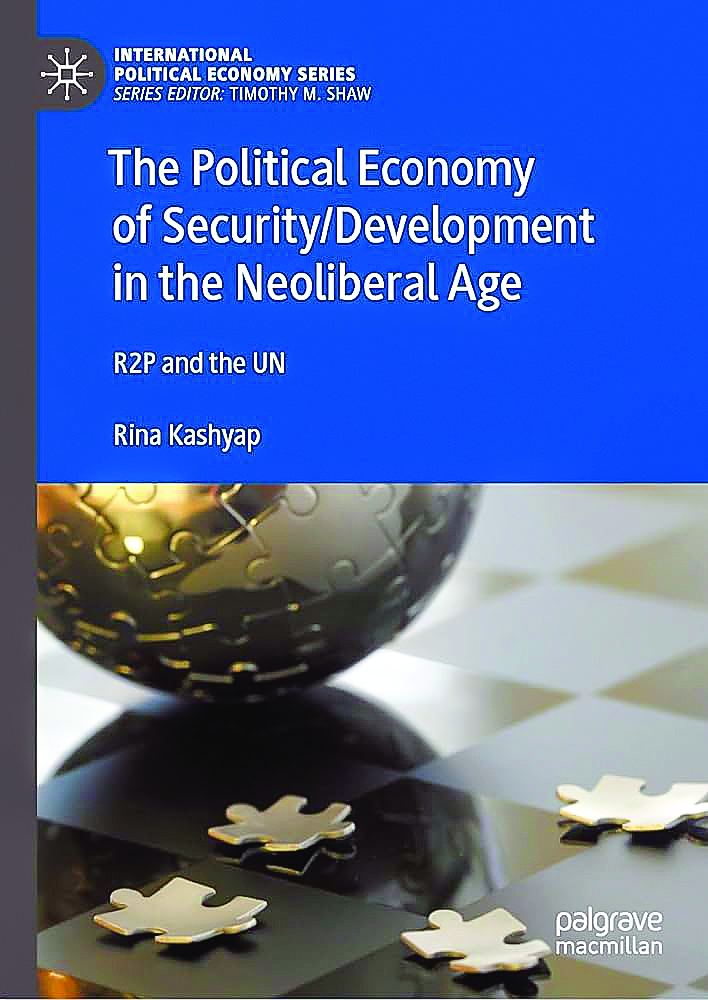NEW DELHI: There is no denying that the book perhaps is the first attempt to bring a number of complex questions relating to R2P and analyse through liberal and neoliberal political economy paradigm.
The volume titled “The Political Economy of Security/Development in the Neoliberal Age: R2P and the UN” by Dr Rina Kashyap is an authoritative source and a very timely effort made in bringing out the dominant discourse on the geopolitical contexts under which the concept on “responsibility to protect (R2P)” came into existence. The formal articulation of R2P by International Commission on Intervention and State Sovereignty in 2001 and the subsequent endorsement by United Nations General Assembly (UNGA) through the outcome document of the world summit held in 2005 really strengthened the idea. It was clearly enunciated that each individual state has the responsibility to protect its populations from genocide, war crimes, ethnic cleansing and crimes against humanity.
It must be emphasized here that this book has made a modest attempt in contextualizing R2P by locating its historical roots in almost every sphere of international relations and their theoretical underpinnings. How the incorporation of R2P at the United Nations has happened within the framework of the UN Charter has formed the part of the debate and analysis in the book. There is no denying the fact that R2P is a continuation of principles of conventional and customary international humanitarian law, international human rights law and international criminal law.
The author has made a comprehensive assessment and established the linkage between security and development in the domains of both theory and practice—how the R2P goals could be realized by not only ensuring the protection of people’s physical security but also how one can understand the obligations of R2P as a semblance of both security and development. The context under which the development has to be understood has been elaborated in a comprehensive manner. The other major focus of the book is to understand the larger political dilemma of choosing between saving human lives and particular development path and how these are addressed.
The author has used the word “development” mainly to connote political economy with a fierce distinction between a liberal and neoliberal political economy. Though free market economy remains central to both liberal and neo liberal political economy but the way things have been unfolding, it is becoming more difficult to have a consensus on the definition of “free market”. How these can be understood through the prism of R2P remains a part of the deliberation in the book. Whether the incorporation of the R2P in the UN can be understood merely as a discursive re-articulation or a discursive shift in their liberal/neoliberal security/development paradigm has also formed a major focus of the book.
The book very systematically has discussed a few key interrelated themes relating to R2P, such as protection, responsibility, sovereignty, morality and legality. The discussion centres around how R2P provides sufficient geopolitical and geoeconomics space for creating liberal/neoliberal subjects like responsible protectors, protected and those who fall outside the domain of protection.
The most notable discussion which has underscored the significance of the World Bank and the International Monetary Fund (IMF) and their policies in accommodating R2P as a factor is by including violent conflicts mainly to analyse the causes and impact and see how these could feature in the larger policy framework and projects. The author has explored how the themes relating to protection and responsibility in the World Development Reports have added value to the dominant discourse in the book on R2P becoming a part of the liberal/neoliberal security dispositif. It has also been emphasised that these financial institutions are not unaware of the political challenges to their work but they deal with it through the apolitical mechanisms of good governance. However, the point of explanation requires more objectivity in providing an understanding that these financial institutions are inclusive and provide a good structure. The lack of good governance can never be the reason of poverty. The World Bank and the IMF can never be apolitical. The World Bank always served the interests of the United States, and the International Monetary Fund (IMF) served the interests of the western hemisphere.
The author has correctly highlighted that R2P is a work in progress. The structures of the global political economy will keep varying and at the same time unfolding. There is enough argument made in the book as to why and how one requires to make R2P more workable so that nothing can stop in enhancing freedom with accountability across the globe. Why it is essential to strengthen the peace building effort of the UN has formed a major part of the book. Afghanistan as a case in point has obviously been a part of the problem for the larger solutions through the strengthening of R2P.
There is no denying that the book perhaps is the first attempt to bring a number of complex questions relating to R2P and analyse through liberal and neoliberal political economy paradigm. It will be an essential read for both theoretician and foreign policy practitioners. It is a well-researched book, very cogent, well-structured, with a lot of well-articulated questions and objectives. The book has also come up with some concrete suggestions for future research in this field. This book certainly is an invaluable addition in the International Political Economy series.
Prof Arvind Kumar is a Professor of United States Studies at School of International Studies, Jawaharlal Nehru University (JNU), New Delhi.

